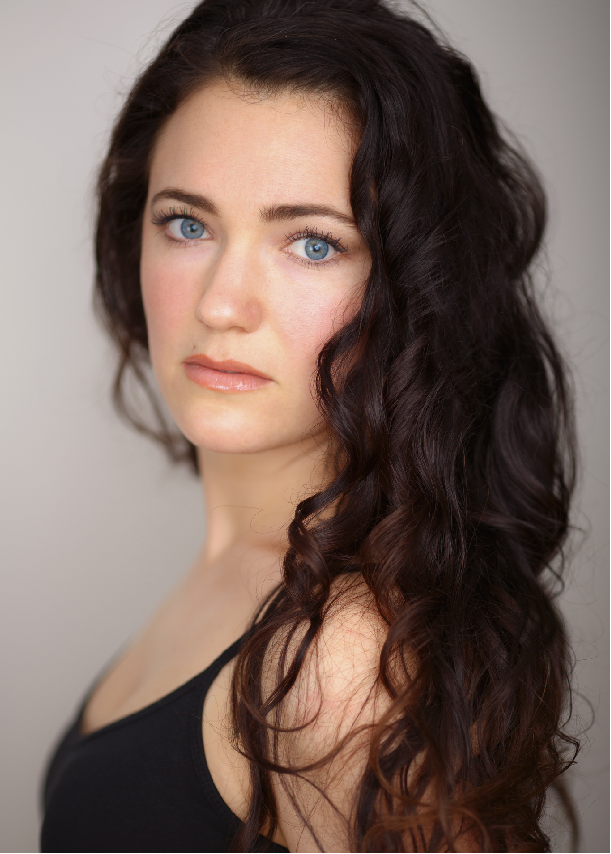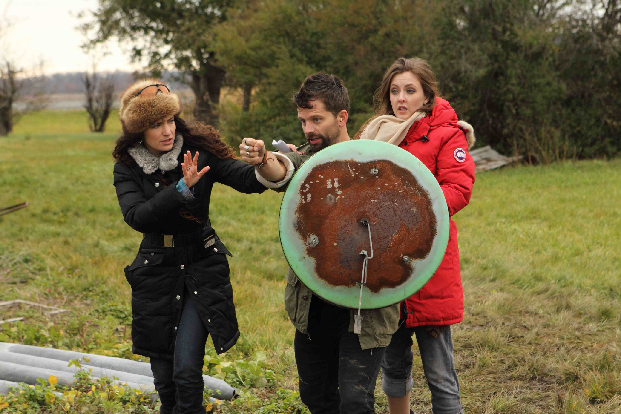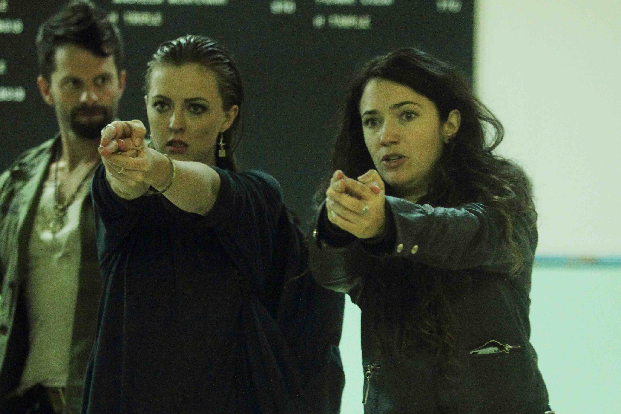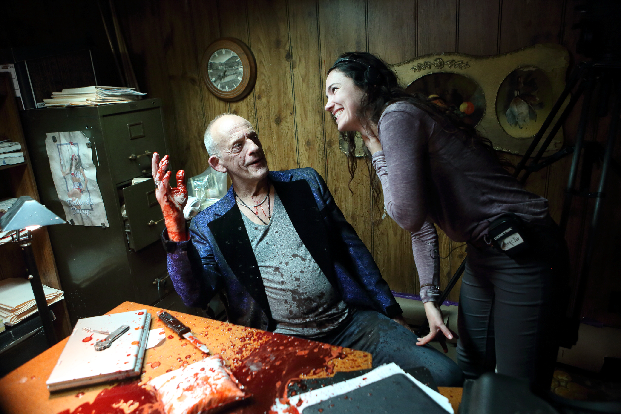Uninhibitedly going after what you want, as you intellectually explore the motivations and circumstances that drive your decisions and actions, is a gripping and intriguing trait for anyone trying to take control over their lives. But that strong ambition is more powerful and enthralling when women protagonists and leaders fearlessly prove that no one has to be afraid to take charge of their destiny, and fearlessly pursue their goals. The main female character in Wango Film‘s new independent action thriller, ’88,’ which is now available on Blu-ray, DVD and VOD, enthralling supports that idea, as she proves that anyone has the ability to fight back against those who are trying to suppress them. Director and producer, April Mullen, also courageously proves that women filmmakers can fearlessly and captivatingly pursue their interests and ambitions through the film’s mesmerizing characters and storyline.
’88’ follows a young woman, Gwen (Katharine Isabelle), who’s contending with a recent case of amnesia and continuously confusing flashback and memories in a dual time line, as she desperately searches to unveil the truth about her past. As she also seeks out clarity and answers about whether she’s the innocent victim or strong-willed, brazen leader she’s remembering, she discovers a bag full of gum balls and a gun amongst her possessions. When she pulls out the weapon to more closely inspect it, she inadvertently causes chaos in the diner she wakes up in, and accidentally kills a police officer. She instantly draws attention from the police force, but goes on the run to find a way to uncover who she truly is, and clear her name.
While Gwen also doesn’t have any memories of how she got the gun or made it to the diner, she realizes that a mysterious and dangerous man, Cyrus (Christopher Lloyd), is also searching for her. While he seems to realize that she doesn’t have any recollection of who he is, she also comes into contact with Ty (the film’s writer and co-producer, and Mullen’s collaborator at Wango Films, Tim Doiron), another person from her past she doesn’t remember. It’s revealed that Ty and Gwen, who he knows as Flamingo, had conspired to kill Cyrus over the death of his sister, Dakota. After speaking with Ty and experiencing her increasingly recurring flashbacks, Gwen realizes she has left a trail of dead bodies behind her, but she refuses to accept her involvement in the murders.
Gwen then finds the key to a motel for room 88 at the Starlight Inn, where she discovers another dead body in the bathroom. There are also photos of a man named Aster (Kyle Schmid) plastered all over the room, leaving Gwen to further ponder why death and violence is following her everywhere she goes. She later discovers that she has deep connections to Cyrus, Aster and Flamingo Club, which makes her situation even more difficult. With Sheriff Knowles (Michael Ironside) close to apprehending her, Gwen must quickly find a way to remember her past and out of jail. Distressed by her subconscious and seemingly obvious connections to the murders, she must also find the drastic event that caused her amnesia and mind’s determination to shield her from the violence.
Mullen generously took the time recently to talk about collaborating with Doiron to create the story for, as well as direct, produce and star in, ’88,’ during an exclusive phone interview. Among other things, the filmmaker discussed how after she and the screenwriter wanted to move out of their comfort zone in the comedy genre and create an action thriller, they crafted the story about Gwen’s amnesia and proneness to violence after they read an article about a person who had woken up in a fugue state; how they cast Isabelle in the diverse leading roles of Gwen and Flamingo, as they not only wanted to work with her, but also thought she would be able to show the strengths and confidence of the female heroines; and how she likes working with practical elements, including utilizing her own props and filming stunts practically, in pre-existing locations, as she thinks it makes the scenes more interesting, realistic and captivating.
ShockYa (SY): You directed the new action thriller film, ’88.’ Why did you decide to helm the movie, particularly after you worked on the script with screenwriter Tim Doiron?
April Mullen (AM): Tim and I were excited about taking on the challenge of making an action thriller. We had been discussing it for about four years, and the story was in development for about two years. We decided to make the story’s structure very fractured, and split it between two different timelines. So the script was our most detailed and planned out one that we ever worked on.
Tim and I have a close working relationship, after working together for eight years. We develop the stories together, and then he writes the scripts, and I direct them. So right from the beginning, we’re on the same page, which really helps with character development and locations. We have a shorthand in how we work.
The story in ’88’ came from an article we read about a person who had woken up in a fugue state. We were intrigued by what happened to the brain of a person who has experienced an enormous trauma in their life. So we wanted to explore what that illness was, and incorporate that into another story we were working on. So the story was based on that fugue state, as well as revenge elements, that we wanted to build upon together.
SY: Katherine Isabelle plays the main character, Gwen, in ’88,’ who goes on a revenge-fueled journey, like you mentioned, as she seeks out the person responsible for her lover’s death. What was the casting process like for Gwen, and how did you decide Katharine was the right actress for the role?
AM: Tim and I are from Canada, and we’ve had our eyes on Katherine Isabelle, who’s also Canadian, for a while. We were looking for a leading lady who would be able to show the strengths and confidence of this female heroine. When she played the role of Flamingo, she really was empowering and dominating. She had no regard for any filters. We needed someone who would be daring, risky and bold, and we found that Katherine was perfect. She has been in several feature films that required a lot out of her, so we felt she would be right for the lead in our movie, and bring that ability to this story.
Plus, we also needed a leading lady who could be vulnerable, fragile and more of a victim to this other, stronger woman. Since the film’s timeline is split between two different people, she had to play two totally different female roles. Katherine found a beautiful balance between Gwen and when she splits into her alter ego, Flamingo, who’s vying for revenge, in the dream state. She’s very powerful and violent. So I think it was an exciting challenge for Katie as an actress, and showcase two polar opposite women.
I feel like every woman has both sides in them-the strong, bold side, as well as the fragile, gentler side. I think that aspect really drew her to the material. It’s an exciting challenge for any actress to really dig their teeth into a huge spectrum on the emotional scale of what they’re going to put into a character.
SY: How did you decide to cast the supporting characters in ’88,’ including Jesse McCartney and Christopher Lloyd, who starred in your previous directorial effort, the 2012 horror comedy, ‘Dead Before Dawn 3D?’
AM: In regards to Christopher Lloyd, both Tim and I had a fantastic working experience with him on ‘Dead Before Dawn 3D,’ which was our last feature film. In that movie, he played a much more classical role that he’s always done, and audiences are much more familiar with him doing. When we were working with him, we found he had a beautiful sensibility, and layers upon layers that he hasn’t been able to showcase recently in his acting.
With Christopher in the role of Cyrus, he’s literally the villain. He plays it so subdued and unique, which is a new experience for him. Tim and I were both really excited to get to watch Christopher in a type of role that he hasn’t ever done before, which is an understated villain, who is really quite dark and evil. We’ve never seen Christopher in anything like his role in ’88,’ which is really exciting.
It’s great that at the age of 75, he’s able to start showcasing other sides of his abilities as an actor. He was mesmerizing, as well as open, raw and honest, in the role of Cyrus, and we sat in awe at the monitors. There were moments you can really see Cyrus’ love for Gwen. Other actors may have played it very tight-laced, but he brought a whole other sensitive side, to go along with the violent side, which was very exciting.
With Jesse McCartney in the role of Winks, he’s literally the one person who really connects with Gwen, and he’s very vulnerable. Jesse was also able to bring a sensitive aspect to the character, which I think audiences will be able to connect with as they’re watching him. He gets swept up into the whole Gwen and Flamingo situation, and he’s the only one who really knows something’s really wrong with Gwen. He’s always trying to help, but has a traumatic ending.
But Jesse as an actor really brought a sense of vulnerability to the role of Winks. We were looking for someone for the character who audiences can really connect with throughout the story. I think Jesse brought that sensibility and almost innocent side to the role. Audiences will really fall in love with him, because he’s almost a victim to the underworld and violence that surrounds him. Jesse did a really great job of bringing a subtle and sensitive side to the role.
SY: Besides directing ’88,’ you also played Lemmy in the thriller. Why did you also decide to star in the film? Did helming the movie influence your acting, and vice versa?
AM: The role of Lemmy was originally meant to be played by a man. Tim and I both come from an acting world, as we both started acting at a really young age. What really encouraged us to start writing, producing and directing was our love for acting, and us wanting to develop new and exciting characters. We’ve cast ourselves in some roles in our features.
So when we were writing ’88,’ we thought, wouldn’t it be fun if Lemmy was actually a female? (laughs) That way we wouldn’t have a generic male gun dealer, and the role ended up fitting me. The character brings moments of levity and comedy, and she’s eccentric in her scene.
SY: Were you able to have any rehearsal time with the rest of the cast to help build the characters’ relationships and backstories?
AM: With the role of Lemmy, I was only on the set acting and directing for one day, as it was a short cameo. It was well rehearsed in advance, and I was preparing for the role all along.
But in terms of me working with all the other actors, when Katie and Christopher arrived on the set in Niagara Falls, we had a session during which we spoke to each other, and discussed the dream state versus the present state. We mapped out for the actors a cheat-cheat, which explained where the characters are, in terms of each timeline, just to make things a bit more clear.
Working on the set with the actors is my favorite part of filmmaking, since I come from an acting background. I love communicating with them. Working alongside Katie and Christopher, we were constantly going back and forth with questions and ideas about character traits, and how to take them to the next level.
I also love going with the actors to pick out their wardrobe and pieces of jewelry that represent their characters. We did all of that during pre-production. A lot of the prep work for the actors is done during pre-production with me. Christopher called me, for example, before he arrived on the set, and told me he wanted to shave his head and eyebrows for the role. (laughs)
We discussed all of those great character choices ahead of time. That way when we’re on set, we’re immediately able to delve into the whole filmmaking experience. So all of the details about what led the characters to where they are in each moment have already been discussed and decided on before we shoot each scene. That way we can literally be in the moment with all the actors, and look at each location as a team, so that we create the best and most honest scenes we can. When the details are created during pre-production, we can enjoy the process on set.
SY: You filmed ’88’ in various locations throughout your hometown of Niagara Falls, like you mentioned. Why do you think filming on location is beneficial in creating an authenticity for the stories you tell in your films?
AM: I am a huge fan of shooting on location. There are so many fantastic locations in Niagara Falls, we’ve shot our last feature films there. With ’88,’ we were able to explore new locations in a city we were already so familiar with overall. Tim and I had locations like The Cadillac Motel in mind, after we did a lot of the location scouting out here before we began shooting. That way I could have those locations in mind when I was coming up with my shot list.
I like working with practical elements and pre-existing locations, while also incorporating our own props, like paintings and colors, into the scenes. I’m also obsessed with using practical lighting, including opening drapes to allow natural lighting in. I like mixing our own elements into locations that already exist, as I think it makes the scenes more interesting.
Tim and I go to Niagara almost a year in advance to start scouting out locations and places that we find cinematic and unique. But we also like to use nondescript places, as well, so that we can create our own world. ’88’ is set in a nondescript town that has its own tone. So we were looking for locations that would not only fit that, but would also allow us to enhance them and make them our own. We wanted to make the film visually and aesthetically unique for audiences.
SY: Speaking of utilizing practical effects whenever you can, why do you prefer doing things practically on the set as you’re filming? Why do you think practically creating and filming the action sequences for the film is beneficial?
AM: Yes, I do. With ’88,’ we decided in pre-production that all of the gunfire and practical effects, including the gumball inside the eyeball and the sewing of the lips, would be done with a fantastic make-up artist. That way we could shoot it in real time on the set.
In terms of the action sequences, I think it’s essential for performers to feel the adrenaline of shooting a real gun. So we used guns with blank bullets. I find that to be essential for the actors and the action. So we used all practical effects throughout the entire film.
It was fun to film with real explosions during the actions sequences. (laughs) The elements of the unknown when dealing with real explosions, which there are two of in the film, is exciting and unpredictable. (laughs) But I think that’s a crucial thing to have for the actors and their reactions. The actors can feel the adrenaline rush through their veins when they shoot a real gun. So we didn’t have to deal with any of the stunts in post (production), which was great. Obviously, it takes more time to use practical effects, and everyone has to wear safety glasses and ear plugs, but I think it was well worth it.
SY: Besides directing and acting in ’88,’ you also produced the film with Tim through your production company, Wango Films banner. Why do you also think producing the films you direct is beneficial? Does your work as a director and producer influence each other at all while you’re making your films?
AM: I think for Tim and I, there’s a really unique work experience with our collaborations. I think because we create our own work, and oversee a project from beginning to middle and end, the producing goes hand-in-hand with the writing and directing.
When we fall in love with an idea, we have so much passion, dedication and commitment to that story, we work hard to find the funding for it. Whether we get the funding through pre-sales or raising the money, that’s part of the process. One film usually takes four or five years of our lives, from the time we start pre-production, to the time we completely finish the last edit.
So we have to love the story and process so much more. It’s difficult sitting at a desk for two years, believing in something so strongly that you don’t give up. But funding feature films these days is extremely difficult. So for Tim and I, the stories mean so much more. We have to love them to really make that commitment, especially when we don’t know if they’re going to happen or not.
So the best ideas and stories are the ones that fly. Once we set our minds to something, we become extremely committed to that film. We love seeing ideas come to fruition, through the ups and downs of funding, casting and distribution. We both are in love with being on set, because that’s when you finally get to see the film’s world come to life. We’re also with other creative minds, which we love.
Then we go into the post world, and begin to heavily market the film. But we really decide which elements to market right from the beginning (of pre-production). That’s when we decide what the poster’s going to look like, and what the hook of the marketing is going to be.
We know we’re going to be in it for the long haul, so we have to know what audience we’re looking for, even before we begin shooting. That way, we’re making the film directly for those people, and have them in the forefront of our minds throughout the whole filmmaking process.
That’s the way we were brought into the industry, so we don’t know any differently. So producing, writing and directing all come naturally. We don’t see the titles as anything other than associating them with our intentions and the story we want to tell. So we do everything we can in every facet, including writing, producing, distributing and marketing. That’s the way it’s always been for us, even when we made our first feature, the micro-budget comedy, ‘Rock, Paper, Scissors: The Way of the Tosser.’
During the last 10 years, we’ve developed a shorthand together while we make our films. That’s what our company does, and we’re always excited to create new things, and get them out for audiences to see.
SY: Speaking of the film’s distribution, ’88’ is now available on DVD, Blu-Ray and VOD. Why do you think the VOD platform is beneficial for independent films like this one?
AM: I think ’88’ bodes well for the VOD and Blu-ray release. Obviously, it’s exciting to also get a theatrical release, because it helps raise more awareness of features like this. But in terms of different platforms, Tim and I are very open to, and excited by, how quickly things can happen in a digital world.
We’re embracing all of the different avenues for audiences to watch the film. Five years ago, some of those avenues weren’t even available. So as filmmakers and producers, we’re excited there are so many different platforms for audiences to watch films On Demand, as quickly as possible. People can now watch films on so many different devices and screens, so we’re just riding that wave. So it’s an exciting time to be at the forefront of embracing those different platforms. For a film like ’88,’ which has a very unique and disjointed element to it, I think it will find its audience through word-of-mouth, after people watch it On Demand.
SY: ’88’ is driven by action sequences, while you infused comedy into the horror elements of ‘Dead Before Dawn 3D.’ Why do you enjoy exploring and incorporating different genres into your films? Besides ’88,’ do you have any other projects lined up that you can discuss?
AM: Tim and I come from a primarily comedy background, but we were excited to make a horror comedy with ‘Dead Before Dawn 3D,’ while ’88’ doesn’t really have any elements of comedy at all. I really love sitting behind the monitor on an action thriller like this one, as it was an exciting, new experience.
I’m just a huge movie lover, and I love all genres. (laughs) I find it very exciting to bring on the challenge of making a film in a new genre. We just shot a paranormal thriller a few months ago, which is a totally different genre for us.
I think our next big project will bring us back to our roots. It’s going to be a big budget paranormal comedy that’s in development right now. We’re also going to make an action drama, and we’re going to start that one in March.
But I would love to try other genres, as I like making films. I love being creative everyday, so I’m very excited to try every genre. There are challenges in making a film in any genre, but I embrace them all, as I’m such a fan of films in general. I see whatever types of film I can get my hands on, and I’ve been like that since I was young.



actress Katharine Isabelle and director-producer-actress April Mullenon the set of their action thriller, ’88.’

Written by: Karen Benardello
